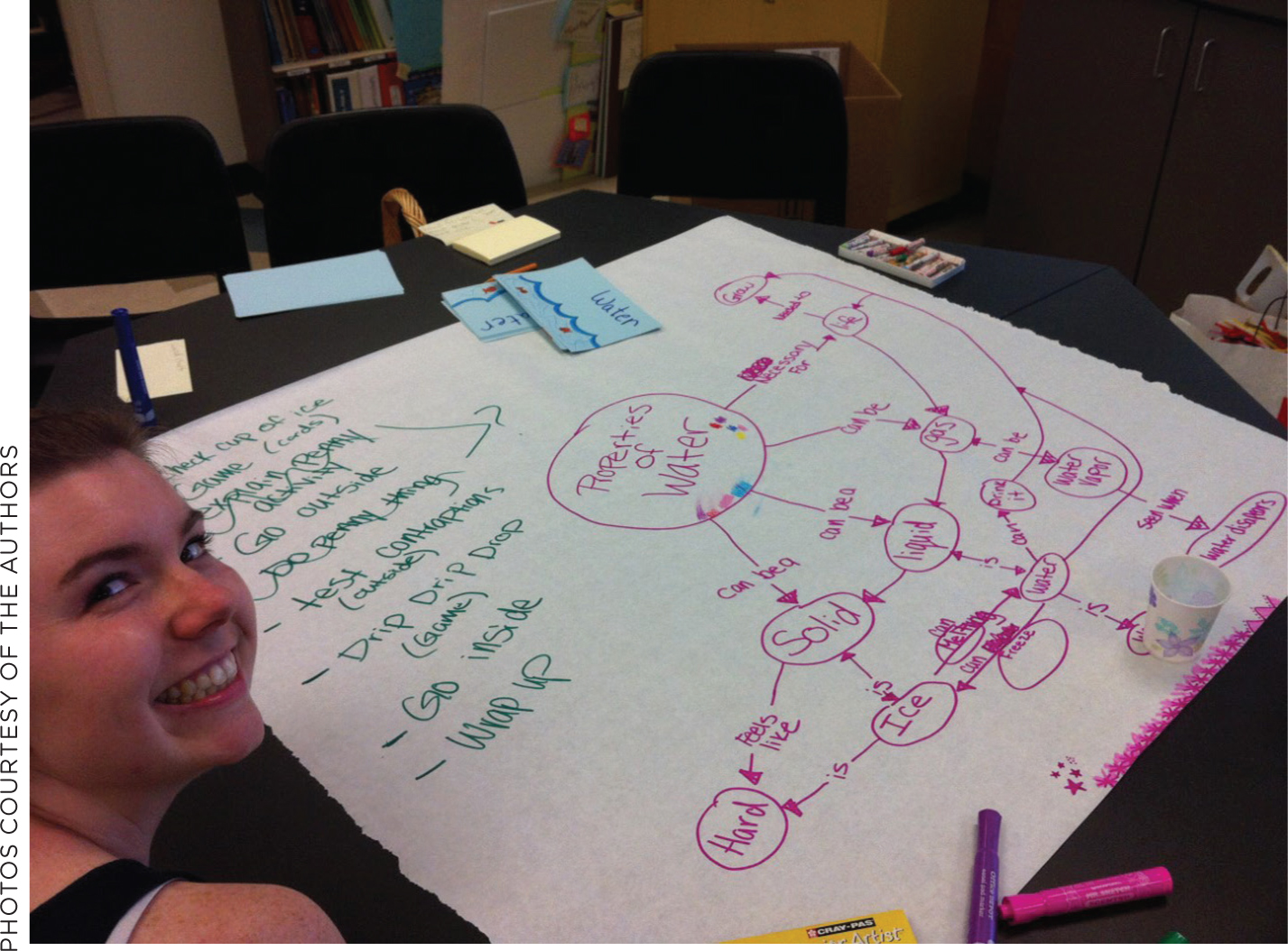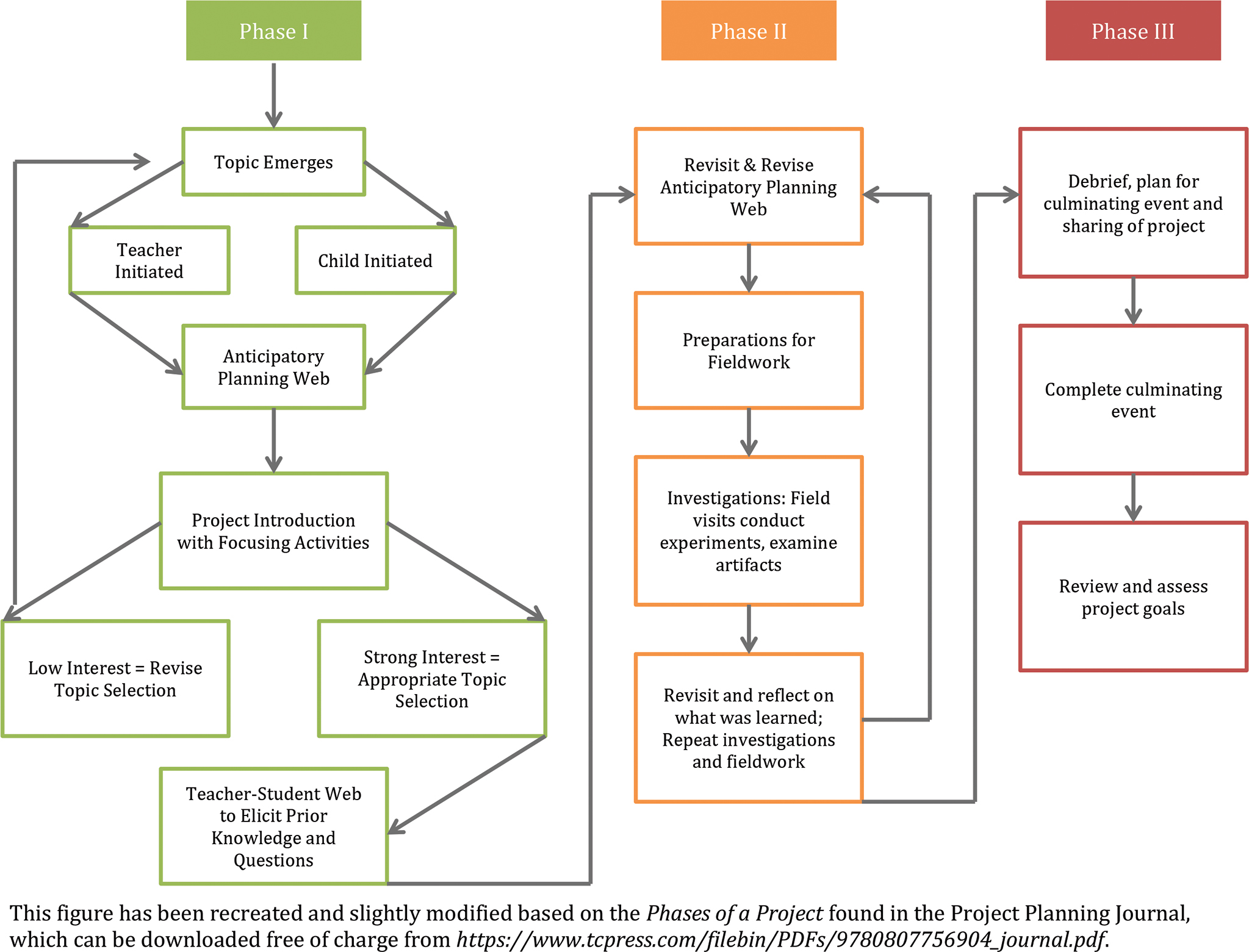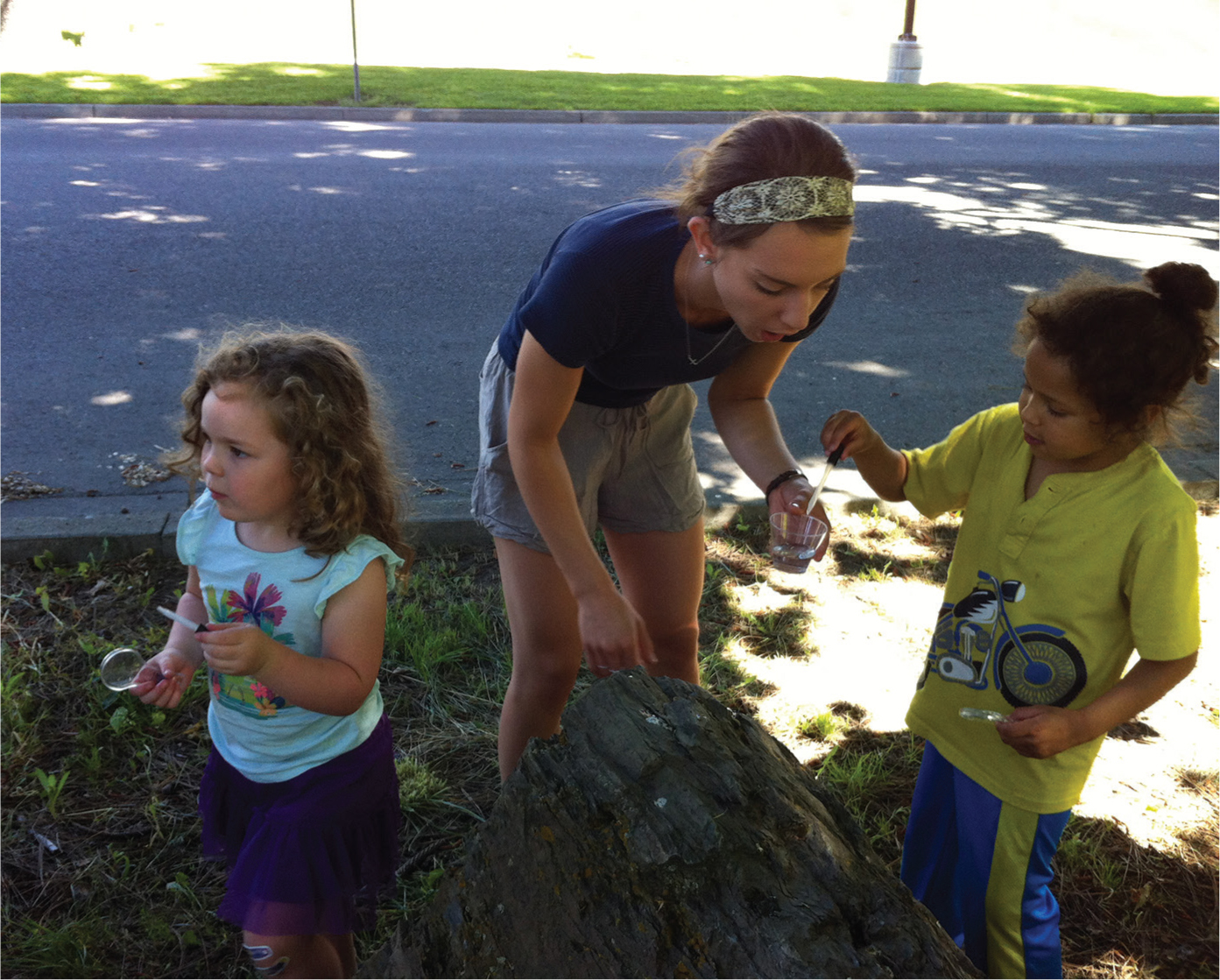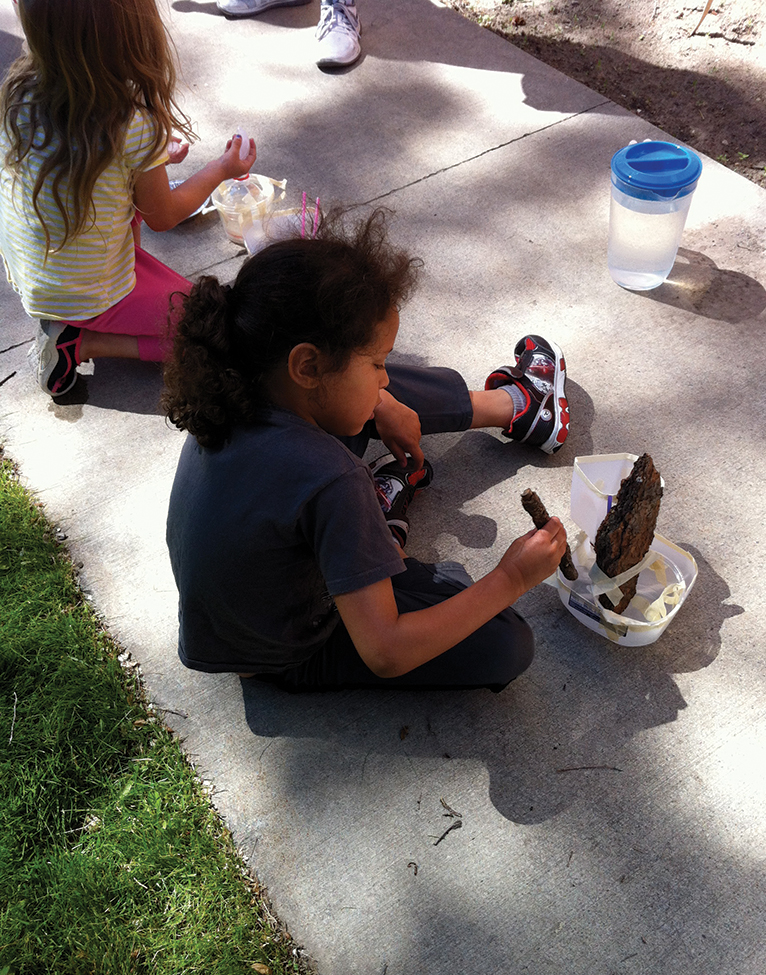Teaching Teachers
Early Childhood Engineering and Natural Resources
Preservice teachers utilize the Project Approach for planning, reflection, and practice.
Science and Children—July/August 2020 (Volume 57, Issue 9)
By Kathryn Baldwin and Allison Wilson
A four-year-old carefully squeezes an eyedropper of water over the cement, “all water is wet.” Another preschooler exclaims, “The ice cube is shrinking!” as she intently observes her ice cube travel down the length of a river-like fountain structure. These were just a few observations of preschoolers stemming from a weeklong investigation spent exploring properties of water. Preschoolers from a campus early childhood children’s center joined forces with preservice teachers from a university education department to investigate water throughout their community. This work was inspired by our work at an institution where preservice teachers take a senior capstone course. The capstone is a culminating course, which affords preservice teachers the opportunity to apply collective knowledge from content and methods coursework to a community service project. These preservice teachers, whom we’ll refer to as teachers, utilized The Project Approach (Harris Helm and Katz 2011) to focus on natural resources over the course of a one-week summer camp with the campus preschool classroom. The Project Approach was chosen as a guiding framework for implementing an emergent curriculum centered on finding answers to questions based on student interests as they relate to their everyday lives and experiences. Although The Project Approach is not exclusive to science in early childhood education, it provides a framework to embed many of the science and engineering practices identified by Next Generation Science Standards (NGSS) and provides a transition from early childhood education to the NGSS.
Five preservice teachers and 15 students were in this classroom. Teachers took turns acting as the lead teacher and the remaining teachers acted as support. If this unit were completed with a single teacher, we would advise finding additional parental support for field investigations. Preservice teachers had planning time (during nap and meal times) and about two to three hours of instruction time each morning and afternoon for five days. The Project Approach capitalizes on students’ interests, which optimizes student engagement and resulting management.

An anticipatory planning web in progress.
Phase I: Getting Started
During the first day of project work, teachers took the morning (without students) to explore components of The Project Approach phases (see Figure 1). In Phase I, a possible topic of investigation emerges as a result of student interests or teacher initiation. When a teacher-initiated topic is chosen, it is important that intentional consideration is given to the potential of beneficial experiences and the likelihood of sustained child interest. Given the project context of a weeklong summer camp, teachers opted to initiate a topic of water. However, if the Project Approach were utilized during the timeframe of a typical school year, the opportunity would allow for a project topic to emerge from children’s interest. Water was chosen as the project focus for a number of reasons: (1) water is something students can relate to, (2) teachers were aware of a number of water resources nearby for field investigation, (3) water is easily accessible, and (4) the unit was during the summer and therefore water play was big on preschoolers minds.

Phases of project work.
Teachers took next steps to develop anticipatory planning webs that outlined potential ways the project might develop (see Table 1). The anticipatory web afforded teachers an opportunity to try out the topic prior to investigation, which also helped teachers to identify any background knowledge pertaining to water that might need to be further researched. The teacher webbing also provided a framework for identifying opportunities to meet content standards through open-ended experiences.
| Table 1. Procedures for anticipatory webbing. | |||||||||
|---|---|---|---|---|---|---|---|---|---|
|
Upon completion of webbing, teachers returned to the preschool classroom to meet the students and introduce the topic of water. Teachers facilitated discussion using a KWL chart, which outlined what students knew and wanted to know about water. Students then had the opportunity to search for water in their classrooms and throughout their school building via a scavenger hunt to provide a focusing activity and common experience to engage students in the topic.
Following the initial meeting with preschool students, the teachers revised their anticipatory web based on their experiences and conversations facilitated through Phase I activities. Based on this initial introduction the teachers felt that the level of interest was strong enough to move forward into Phase II and further investigation. In particular, students were enthusiastic to share a book from their classroom library that included a snowman. The book turned out to be a catalyst for conversation on the topic of snow melt, which was seasonal given our recent transition to warming weather in our region. These conversations would foreshadow future project work and sustained topic interest.
Phase II: Investigation
On day 2, the teachers returned to build on their conversations and water scavenger hunt. The project began with the “Acting Like Rain” lesson (Baldwin and Wilson 2017) as a primer for student engagement in conversation about water. Rather than using “Acting Like Rain” as a stand-alone lesson, we incorporated this lesson into the Investigation phase of our larger project. Before going out to do field work, the teachers discussed safe field practices (holding hands while crossing the street, leave rocks on the ground, and so on). The project proceeded with fieldwork at the park near the Children’s Center. Here, students made predictions about how they thought water would behave when dropped onto different surfaces and recorded this information on a student sheet (Baldwin and Wilson 2017). Students were asked, “What do you think will happen if we put a drop of water onto this tree, will it soak in or roll off? After directions on how to safely use the plastic droppers, students proceeded to “act like rain” and test their predictions on various natural and designed objects at the park. Some of the objects students decided to test included: tree bark, mulch, grass, sidewalk, picnic tables, swings, stairs and slides. Following fieldwork, students analyzed their data (sketches, notes, observations) with teachers and discussed water behavior on different surfaces. Conversation included how on designed surfaces, such as plastic, water rolled off, but on many natural surfaces, like tree bark, the water soaked in.
Day 2 discussion closed with an emphasis on the word resources and how plants and animals use water. When asked what they knew about water, many students indicated they knew that we use water, which teachers expanded upon and asked, “How do we use water?” Students responded, “Drink it,” “wash with it,” “swim in it” and so on, and interest centered on questions related to water temperature. They asked, “Do hot and cold water look different?” and “Do hot and cold water act different?” The teachers capitalized on this interest and used this question as an opportunity to fine tune further investigations, which led to intentional planning for exploration of water properties the following day.

Students “Act Like Rain” on a rock in the park.
Fieldwork
Building on student interest and to prime discussion on the properties of water, the teachers started day 3 with ice painting. Students took individual ice cubes and “painted” on the sidewalk as the ice melted. They drew pictures, wrote their names, and so on. Teachers were intentional to promote concept development and build on the experiences of children through quality feedback and conversation: “What happens to the ice as you paint?” “Is the painting easier on the grass or sidewalk?” The ice painting was followed by further exploration. Teachers revealed two large blocks of ice (previously made the night before using lasagna pans). Teachers prompted students to make a prediction of what would happen if the ice blocks were left outside. Students predicted that the ice would melt. The teachers then provided students with the opportunity to suggest the location of where the blocks would be placed. Collectively, the students decided to place one block of ice in the sunny grass and one under the overhang on the sidewalk. In order to measure the amount of melting between locations, teachers assisted the students in tracing the large blocks of ice onto a piece of paper. The plan was to retrace both blocks of ice later in the day. The teachers then asked the students to predict what they thought would happen to each block of ice in the two locations. Students predicted that the ice under the overhang would melt less as it was in the shade. They predicted the ice in the grass would melt more because it was in the Sun.
After lunch, and prior to the class heading outside to check on the blocks of ice, one of the teachers stepped out to investigate. To her astonishment, the results were the opposite of what they had predicted. The block in the Sun (and also in the grass) had barely melted! However, the ice block in the shade (under the overhang, but on the sidewalk) had almost disappeared. In a panic, she asked, “Should I move it?” We responded with, “Absolutely not!” The teacher looked perplexed, as if there had been a mistake, or as if someone had switched the blocks as a cruel joke. We asked her, “Other than being in the shade or Sun, are all other variables the same?” She then noticed that they were on different surfaces and suggested that might have contributed to the difference. The teachers left the blocks where they were. When teachers asked what happened to the ice, students used the words melt, shrinking, and disappear. The students also thought that someone could have taken their ice block, but also observed the small puddle of water that still remained, a piece of evidence that “Sunlight warms Earth’s surface” and the block of ice may have in fact melted (see DCI PS3.B). Students retraced the large blocks and revisited their predictions. Teachers used this as an opportunity to talk about variables and the nature of science, focusing specifically on how predictions are not always correct and that is not bad thing! We learn from our predictions. The unexpected event continued to fuel the preschool students’ enthusiasm for further investigation.
Later that afternoon, students visited fountains located around the local university campus for fieldwork. Traveling with clipboards, notebooks, and recording tools, students made observations about how the water moves and behaves. One of the fountains runs like a stream before the water is recycled. The students dropped pieces of ice in the fountain to observe water movement. The students noticed that there were a number of places where the ice “got stuck” and described that water is “pushing them down.” Building on this observation, the teachers and students continued discussion and added this to their understanding of how water moves. Up until now, all of the project investigations were intentionally designed to elicit prior understanding, inspire observations, and encourage questions regarding how water behaves and how it moves. The teachers noted the students using the word disappear and wanted students to be able to see the ice was not disappearing. The question was posed, “Where did the ice go?” This inspired the focus for the engineering challenge scheduled for the remainder of the week. “Because water is such an important resource, we want to design an invention to collect water as ice melts.”
Investigation and Representation
Day 4 began with students revisiting conversations and opportunities for fieldwork from earlier in the week (acting like rain, visits to the fountains, ice painting, testing ice melting conditions). Through these conversations students reflected on their prior learning; water soaks into some surfaces and rolls off others, water moves “down,” ice melts into water, and conditions can change how quickly the ice melts and how water moves. This led to the engineering design challenge: build a water collecting device. After a reminder about field trip safety, students collected natural artifacts outside from their campus community (in an area determined by the teachers) for designing their inventions. Additionally, teachers supplemented natural artifacts with a number of human-made materials as options for their design (e.g., cups, cardboard, foam swim noodles). Teachers intentionally guided students to utilize loose parts (Daly and Beloglovsky 2015) to encourage ingenuity and innovation of students while they planned for and carried out their investigation. Once materials were gathered, students proceeded to sketch blueprints prior to construction. The construction process involved many iterations of water collecting devices for each child. The morning was primarily spent planning and testing different materials, while the remainder of the afternoon was used for building, testing, and refining designs. Since students recognized from the earlier ice block investigation that ice melts into a liquid, preschoolers tested their devices by pouring liquid water to ensure that their contraption would capture what they predicted would eventually melt. Each device was tested and blueprints refined until each student felt confident with a final device for “unveiling” the next and final day of project work. Day 4 concluded with an initial brainstorm with students for how to showcase and culminate their project work.

Students build and test their individual water collecting inventions.
Phase Three: Concluding the Project
In Phase III and the morning of day 5, the teachers facilitated an opportunity to debrief and plan for a culminating event for students to share their knowledge and the overall story of their project. The culminating event would include a showcase of each individual student’s water collecting device and a larger, collaborative prototype. The collaborative prototype utilized a combination of the most successful components from testing. The morning was spent creating a large-scale blueprint and organizing individual student displays. When teachers asked students who they would want to view their displays, students responded, “mom!” “brother!” “teacher Anna!” Since the classroom was part of a larger early childhood center with 11 classrooms total, the students decided to invite others in the immediate preschool community, and family, to their afternoon unveiling of individual inventions and testing of their larger prototype. This involved the making of paper invitations and delivery to individual classrooms and a flyer posted at the front office for parents to see when they picked up in the afternoon. They described their project: “We made our final contraption from a funnel made from a milk jug, a pool noodle, tape, a bakery container, string, ribbon, straws, and pipe cleaners. We put ice cubes in the top. The Sun melted them, and turned the ice to water. Then the liquid collected in the bottom.” Through the creation of the water catching device, children were able to revisit and reflect upon an otherwise abstract concept that occurs over time. Preschoolers were able to articulate how ice, a solid form of water, could transform into a liquid when exposed to heat from the Sun (PS3.B). The culminating event of creating the water collecting device provided an engaging platform for preschoolers to activate prior knowledge, reflect on previous water and ice field work, and apply their new understandings to design, test, and refine (ETS1.A, B, and C) their knowledge of water properties. The culminating event included ice pops as a snack to celebrate as well as a documentation display, which showcased the quotes, stories, photos, and experiences of students throughout the week as they related to project work. Students from other classrooms, program staff, and parents attended the event “open house” style and student inventors were able to provide an oral account of their project work (see Table 2 for assessment details). The documentation display remained in the lobby of the school for a few weeks following the event so that students, parents, and program staff could revisit and celebrate the project accomplishments of the students.
| Table 2. Assessment in project work. | ||||||||||||||||||||
|---|---|---|---|---|---|---|---|---|---|---|---|---|---|---|---|---|---|---|---|---|
|
||||||||||||||||||||
Reflecting on Project Work
We noticed the teachers embedded many of the science and engineering practices throughout the project. The most prominent practice was Planning and Conducting Investigations, which aligns well with Phase II of The Project Approach. Teachers and students spent the week using The Project Approach and the science and engineering practices to tackle an engineering challenge. The teachers set the stage with a single natural resource, water, and capitalized on the student interest in ice to drive the project. Students then learned about the properties of water and how conditions can change water’s behavior. The result? Many creative water collecting inventions!
Kathryn Baldwin (kbaldwin1@ewu.edu) is an associate professor of science education at Eastern Washington University in Cheney, Washington. Allison Wilson (allison.wilson@mso.umt.edu) is an assistant professor of early childhood education at the University of Montana in Missoula, Montana.
Preservice Science Education Professional Learning old Teacher Preparation Early Childhood Elementary


